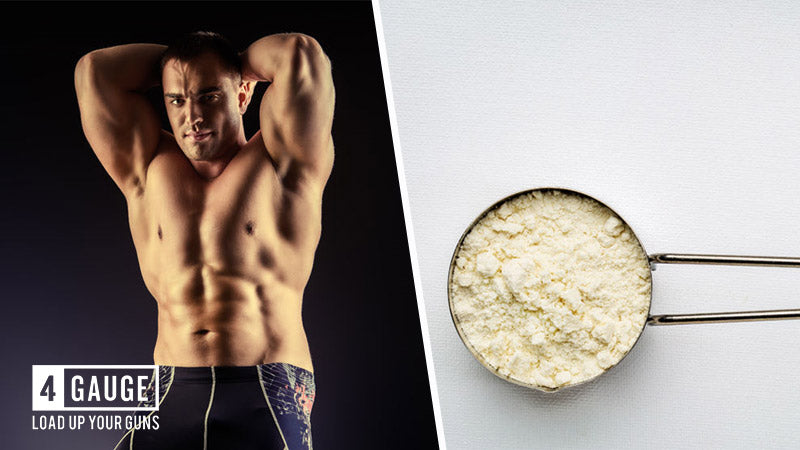Flash Sale!
Buy 3 Bottles of 4 Gauge ELITE,
Get 1 FREE + a FREE Shaker Bottle!
This store requires javascript to be enabled for some features to work correctly.

The key to a big gym session is to dial in. To feel pumped and ready. And in the competition between you and the iron there’ll only be one winner.
How? A good pre workout.
The devil is in the detail. Get the right mix of stimulants and you’re well on your way to showing the gym who’s boss.
So should you be looking for agmatine sulfate in your post workout blend?
In this article we break down the science and take a look. Here’s what we’ll cover:
Agmatine sulfate (AS) is a decarboxylated metabolite of the amino acid L-arginine. It is a salt form of agmatine discovered back in the early 1900s.
Although originally it was thought not be synthesised by the human body, recent research has found it in various tissues and organs, especially in the stomach, small intestine and adrenal glands [1].
You’ll also find it in foods such as shellfish, meat and fermented foods such as coffee, wine and beer.

We’ve written about nitric oxide (NO) in our articles before – particularly this one on the best ingredients for muscle pumps.
Nitric oxide is the vasodilating compound that determines how intense your muscle pump is. That muscle splitting feeling you get during and after a big weights session. Its production relies on L-arginine.
Not only does it help make you look muscular and vascular but it also helps you train harder for longer because you can deliver more nutrients to the muscle. It reduces fatigue so you can achieve a higher volume workout too.
All in all, nitric oxide is a great asset to anyone who trains regularly; and trains hard.
Nitric oxide production is controlled by a small number of enzymes – one of which is called endothelial nitric oxide synthase (eNOS).
The enzymatic reactions are complicated but all you need to know here is that L-arginine converts to nitric oxide in the blood via citrulline and the NOS enzymes.
There may be a small amount of evidence that agmatine regulates eNOS production, which of course helps NO to increase in the muscle.
But there isn’t a great deal of research to suggest this other than the odd animal study [2].

Agmatine is considered to be a neurotransmitter and neuromodulator. This means that it has an effect on your neurons and nervous system receptors.
As such, AS may have a positive effect on mental stress as well as pain sensations.
There aren’t a vast number of studies that back this up, but the one or two that do exist are interesting.
A study in Pain Medicine [3] found that supplementing up to 3.5 grams of AS per day helped a group of herniated lumbar disc sufferers significantly reduce the pain that they felt.
This occurred within 14 days of taking the supplement and persisted for 80 days after dosages were stopped.
Further research in this area suggests that AS works much better when combined with pain killers such as morphine.
High doses of 2-3 grams of AS have also been found to reduce symptoms of low mood in a group of depressive or unipolar depression sufferers.
It’s worth noting though that the high doses used in these studies are much higher than the ~0.75 grams you’d find in a pre workout.

Agmatine sulfate has been used in pre workouts for years.
It is largely marketed as a bodybuilding supplement with the ability to enhance athletic performance whilst at the same time promoting recovery and mood – everything you’d want from a supplement.
The problem is though that the science isn’t quite there yet.
AS is added to pre workouts as a nitric oxide stimulator and motivator. The problem is though that when you look at the research, compounds such as citrulline malate and beetroot extract are more reliable.
To date, there have been no actual studies that back up AS as a performance booster.
Although it might prove to be an interesting compound, its reliance on animal studies to find any benefits mean that it isn’t as widely used as other more reliable pre workout ingredients.
Based on current evidence we’d say you should have agmatine well down your list of priorities. There’s no real science to back up the claims that it can enhance performance or promote recovery.
And with much more robust nutrients such as citrulline malate and beetroot available, we’d suggest focusing your attention on a more reliable pre workout supplement.
4 Gauge is an exhaustively tested, all natural pre workout with the best ingredients you’ll find.
This explosive pre workout contains 8 powerful clinically dosed nutrients including caffeine anhydrous, L-theanine and creatine monohydrate to give you PR-crushing, cell-splitting, muscle tearing workouts.
